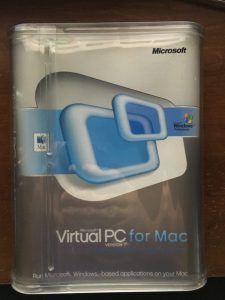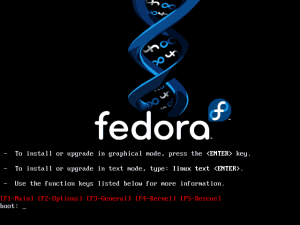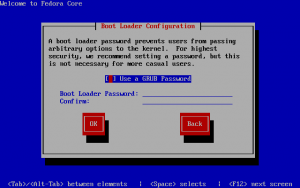Architectural Wizardry of the Mid-2000s, featuring Fedora Core 6

Virtual PC Box
Nevertheless I loaded up my copy of Microsoft Virtual PC for Mac 7.0.2 from
2005 and noticed an unexpected option for a guest operating system: Linux.
Attempting to install a modern distribution yields no love as VirtualPC
doesn’t support DVD images (plus Fedora 24 wouldn’t exactly be fair
to my decade-old PowerBook). Instead, I opted for the equally ancient Fedora
Core 6, released in 2006, and still available from Fedora’s archive.

Boot Splash
Along the way, I noticed a couple features that aren’t present in the
modern installer. For example, one section that asks for extra kernel options;
another section offers to set up a bootloader password in GRUB. Also of note
was that the Fedora Core 6 installer set up an LVM scheme by default. I
certainly didn’t expect that from a distribution from the days when
Ubuntu looked reminiscent of a construction site with all its
white and orange.

Why Isn't This in Fedora 24
When the system finally came up, I received (unsurprisingly) a black screen, followed by a garbled mess. Thanks to a Debian How-To, I found the solution was to change the color depth in /etc/X11/xorg.conf to 16-bit. Booting with `vga=794` in the kernel line and directing X.org to use the fbdrv driver as the debian article suggested gave me 1280×1024. It’s not the PowerBook’s native 1680×1050, but it’s close enough to outweigh my desire for higher resolutions in favor of just not wanting to tempt X any further.
At this point it became clear that my PowerBook just doesn’t have the grunt to translate binary instructions in real-time all the while putting up with 1280×1024 worth of pure, unadulterated, Linux from 2006. It is only a late 2005 model, after all.
Still, I can’t say I’m disappointed with my success so far. I never anticipated I’d get X started, let alone have it usable (if laggy) in 1024×768. Perhaps I’ll experiment with Fedora Core 6 on more powerful hardware in the future, but for now, I declare this witch trial closed.